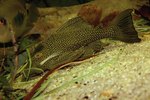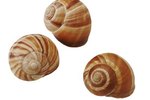
The spotted puffer can belong to one of two species, Tetraodon fluviatilis or T. nigroviridis. To make matters more complicated, they also sell under several other common names including the green puffer and the spotted green puffer. It is a small to medium sized pufferfish that lives in freshwater and brackish water across its habitat.
In the Wild
In the wild, this spotted puffer lives on a diet that includes a number of small, crunchy invertebrates. These include mollusks like snails and small crustaceans, which they break open with their powerful beaks. It has also been known to nibble on plants and debris, although the bulk of its diet is primarily carnivorous.
In Captivity
In captivity, these fish generally refuse prepared foods, like flakes and pellets. However, they will readily eat live and frozen foods. This includes live shrimp, and frozen, meaty foods available at many pet shops like frozen bloodworms and Daphnia. Small snails, a nuisance in most aquariums, make a great puffer food. Additionally, spotted puffers will enjoy the occasional treat of seafood from the grocery store. Any kind of shellfish fed to these fish should still have the shell.
Beak Sharpening
Like many puffers, the spotted puffer's beak grows continuously. Under aquarium conditions, the beak can overgrow the fish's mouth. This can cause problems for the puffer, and make it difficult to feed. For this reason, the spotted puffer's diet must include shellfish and snails, which will help wear down the puffer's beak and keep it from growing too long.
Poison
While wild specimens of this pufferfish are poisonous, captive specimens are not. This happens because the spotted puffer does not produce the poison itself. Instead, it gets the poison from microorganisms in its diet. The puffer concentrates this poison in various tissues, making it deadly if eaten. In captivity, it does not have access to the same microorganisms and thus doesn't have any poison.
References
Photo Credits
-
Hemera Technologies/Photos.com/Getty Images



